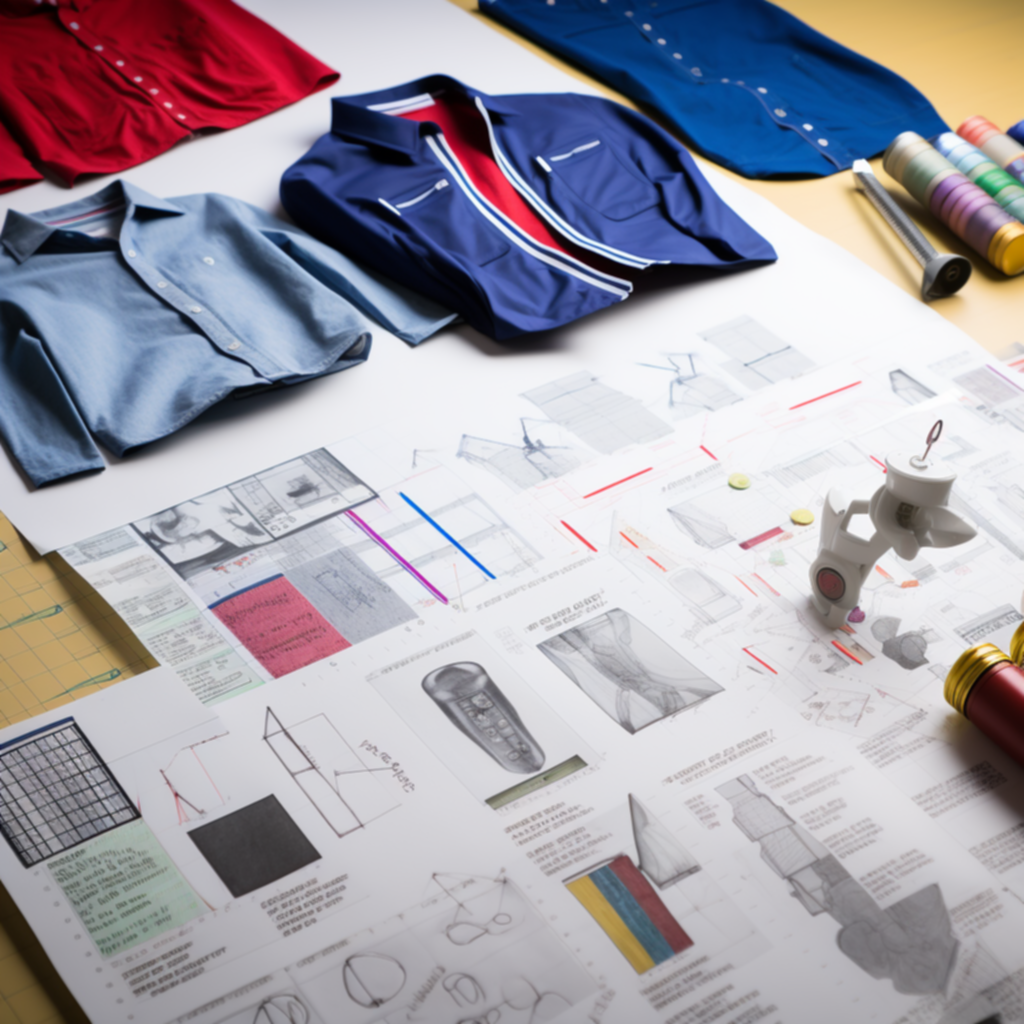The Ultimate Guide to Creating a Tech Pack for Garment Manufacturing


Stepping into the vibrant world of fashion design? Whether you're a seasoned designer or a fledgling brand, a tech pack serves as your blueprint for success. This document is indispensable in translating your creative vision into a tangible product. The absence of a well-structured tech pack can cause delays, increased costs, and, most devastatingly, a final product that doesn’t meet your standards.
In this comprehensive guide, you'll discover what a tech pack is, why it's crucial for your business, and how to craft one that streamlines your production process. With detailed insights, practical steps, and expert recommendations, we aim to equip you with the knowledge needed to create an effective tech pack that adheres to industry standards.
What is a Tech Pack?
Definition
A Tech Pack, short for Technical Package, is a comprehensive document that serves as the bridge between your design vision and the tangible product. Think of it as a blueprint that guides the manufacturing process, detailing every aspect, from materials and dimensions to stitching and packaging.
Importance in the Fashion Industry
In an industry that celebrates creativity, you might wonder why such a technical document is needed. Yet, it's the technicalities that often define a product's success. Here's why:
- Clarity and Consistency: Manufacturers may not speak your creative language. A tech pack translates your designs into a language they understand, ensuring that everyone is on the same page.
- Cost-Efficiency: Time is money in fashion. A well-executed tech pack minimizes back-and-forth communication and revisions, thereby reducing costs.
- Quality Control: A good tech pack leaves no room for guesswork, helping you maintain the quality of your garments throughout the production process.
- Global Communication: In an era where manufacturing could be halfway across the globe, a tech pack ensures your instructions are clear, no matter the geographical or language barriers.
- Legal Safeguard: Should disputes arise over the quality or specifics of an order, your tech pack serves as a legal document that clarifies your initial requirements and expectations.
Knowing the importance of a tech pack, the next logical step is to understand its components. What makes a tech pack complete and effective? The ensuing chapter delves into this vital information.
Essential Components of a Tech Pack
A robust tech pack comprises various sections that serve specific purposes. Below are the integral parts you should never overlook:
Cover Sheet
The cover sheet acts as the face of your tech pack. It contains essential details like the product name, season, designer's name, and other critical references. This first glance should be organized and easily understandable.
Sketches and Design
Flat sketches offer a 2D representation of your design, showcasing both the front and back views. It's crucial that these are as accurate as possible to prevent misunderstandings during production.
Materials and Fabrics
This section specifies the types of fabrics and materials you wish to use. Information on fabric composition, color codes, and even the supplier details should be listed here. The more precise you are, the easier it will be for the manufacturer to meet your expectations.
Stitching and Construction
How your garment is stitched and assembled is crucial for both aesthetic and functional reasons. Specify the types of stitches, their location, and any special construction details to ensure the garment is made to your exact specifications.
Sizes and Measurements
It's crucial to outline the sizes you want your garments to be produced in. Include a detailed size chart and measurement guide that the manufacturer can refer to.
Labels and Tags
This section is for specifying the types, sizes, and placements of labels, hangtags, or any branding materials you'd like to add to your clothing.
Packing Instructions
Don't overlook the importance of packing your products well. Specify how you want the garments folded, bagged, and boxed. Outline any requirements for special protective packaging or tags.
By ensuring each of these components is well-detailed in your tech pack, you're well on your way to creating a garment that matches your vision while adhering to quality and industry standards.

Software Tools for Creating Tech Packs
Creating a tech pack is a meticulous task that demands attention to detail. Thankfully, software tools are available to facilitate this process. These tools range from industry-specific applications to general design software. Here's a breakdown:
Industry Standards
- Adobe Illustrator: Widely used in the fashion industry for its precision in creating vector sketches. Illustrator's comprehensive features allow designers to add comments, dimensions, and other critical details directly to their designs.
- PLM Software: Product Lifecycle Management software like Centric PLM offers a full suite of features for fashion design, including tech pack management. These are generally used by larger enterprises.
- Gerber YuniquePLM: Known for its ease of use, this software integrates seamlessly with other Gerber products and offers robust features for creating and managing tech packs.
- Budget-Friendly Options
CorelDRAW: A more affordable option than Adobe Illustrator but still offers a wide range of features suitable for fashion design sketches and tech pack creation. - Microsoft Excel: While not a design tool, Excel's grid system can be extremely useful for creating tables for measurements, material lists, and other text-based information. Some designers use Excel in conjunction with other design software.
- Google Drive: Using Google Sheets for text-based info and Google Drawings for sketches is a cost-effective way to collaborate in real-time with team members.
Each tool has its pros and cons, so the right choice depends on your specific needs, budget, and the complexity of your designs.
Now, armed with the knowledge of what goes into a tech pack and the tools you can use to create one, you're ready to start crafting your own.
How to Create Your Own Tech Pack: A Step-By-Step Guide
Creating a tech pack is a multi-step process that requires meticulous planning and attention to detail. Here’s a practical guide to help you develop a comprehensive tech pack.
Gathering Information
Before you begin, gather all necessary information including design sketches, fabric samples, and preliminary measurements. This forms the foundation of your tech pack.
Designing Sketches
- Initial Concept: Start with a basic sketch, outlining your design.
- Detailing: Add essential features like pockets, buttons, zippers, or any unique design elements.
- Finalize Sketch: Utilize design software to finalize your sketches, creating a clean and professional look.
Material Sourcing
- Fabric Selection: Choose the fabric and obtain swatches if possible. Note the fabric weight, composition, and any other relevant details.
- Trims and Notions: Select buttons, zippers, and other hardware. Note their material, dimensions, and placement.
- Size Charts and Measurement Guides
- Initial Measurements: Start with a base size and note down its measurements.
- Size Grading: Use the base size to create additional sizes, noting the measurements for each.
- Tolerance: Include tolerances for each measurement to allow for slight variations during manufacturing.
Creating the Tech Pack
- Cover Sheet: Compile all key information like product name, season, and designer.
- Sketches: Include finalized sketches, both front and back, with any noteworthy details.
- Materials: Insert your fabric and materials section, along with supplier information if available.
- Construction Details: Add the stitching and construction section, describing the types of stitches and their locations.
- Size Charts: Include the finalized size charts and measurement guides.
- Labels and Packaging: Add your branding and packaging specifications.
- Final Review: Double-check all sections for accuracy and completeness.
This step-by-step guide aims to facilitate the creation of your tech pack, making it an invaluable asset for your fashion journey. By meticulously following these steps, you pave the way for a smoother, more efficient manufacturing process.
Mistakes to Avoid When Making a Tech Pack
Creating a tech pack is a nuanced task. While it may seem straightforward, certain pitfalls can complicate your manufacturing process and compromise the quality of your garments. Here are some mistakes to steer clear of:
Lack of Detail
Insufficient detail in your tech pack can lead to misunderstandings with your manufacturer, resulting in a product that doesn't meet your expectations. Be as explicit as possible about materials, measurements, and construction techniques.
Skipping Prototypes
Skipping the prototype stage is risky. Always create a prototype and revise your tech pack accordingly to ensure the finished product meets your standards.
Ignoring Tolerance Levels
Tolerance levels account for minor variations in size and materials that naturally occur during production. Not specifying these can lead to unexpected issues in the final garment.
Poor Quality Sketches
Your sketches must be clean, clear, and professional. Unclear or amateur sketches can lead to incorrect interpretations by the manufacturer.
Inadequate Material Specifications
Merely stating "cotton fabric" is insufficient. Specify the type of cotton, its weight, and even the preferred supplier to avoid discrepancies.
Overlooking Branding Elements
Labels, tags, and packaging are essential for brand recognition. Neglecting this section may result in a generic-looking product that lacks brand identity.
Not Updating the Tech Pack
As you make changes, update your tech pack accordingly. An outdated tech pack can result in a final product that does not reflect your most recent decisions and improvements.
Avoiding these mistakes will not only help you create a more accurate tech pack but also foster better relations with your manufacturer, ultimately producing a garment that aligns with your vision and quality standards.

Why Outsourcing Might Be a Good Idea
Creating a tech pack is a labor-intensive process that demands specialized skills and a keen eye for detail. While it's feasible to create one yourself, especially with the guide we've provided, there are situations where outsourcing might be a more practical choice. Here's why:
Expertise and Experience
Professional tech pack services bring a wealth of experience and knowledge to the table. They're familiar with industry standards and know what manufacturers look for in a tech pack, thereby minimizing errors and misunderstandings.
Time-Saving
Creating a comprehensive tech pack is time-consuming. Outsourcing allows you to focus on other vital aspects of your business, like marketing and sales, while experts handle the technicalities.
Consistency
Seasoned professionals have standardized processes for creating tech packs. This ensures consistency, a crucial factor if you're planning multiple collections.
Legal Assurance
A professionally prepared tech pack serves as a more potent legal document in case of disputes with manufacturers. They often come with clauses and stipulations that protect your interests.
Revisions and Updates
Most professional tech pack services offer revisions as part of their package. This means you can make modifications without diving back into the complexities of the document.
Cost
While there is a financial outlay involved in outsourcing, consider it an investment. A well-crafted tech pack can save you money in the long run by reducing production errors and delays.
Outsourcing the creation of your tech pack is an option worth considering, especially if you lack the time or expertise to create one yourself. It can serve as a strategic move to ensure that your vision comes to life just the way you've envisioned it.
FAQs on Tech Packs
What is a tech pack used for?
A tech pack serves as a blueprint for manufacturing a garment. It contains detailed specifications, from design sketches to material types and stitching instructions, ensuring everyone involved in the production process is aligned.
Can I create a tech pack myself?
Yes, you can create a tech pack yourself using various software tools. However, it's essential to have a solid understanding of garment construction, materials, and manufacturing processes to ensure accuracy and comprehensiveness.
Do all manufacturers require a tech pack?
While not all manufacturers strictly require a tech pack, having one greatly minimizes misunderstandings and production errors. It's considered a best practice in the fashion industry.
How often should I update my tech pack?
You should update your tech pack whenever you make changes to the design, materials, or any other specifications. An outdated tech pack can lead to production issues.
What is the cost of creating a tech pack?
The cost can vary depending on whether you do it yourself or outsource it. Doing it yourself will require a software subscription, while outsourcing can range from $100 to $800 per tech pack, depending on the complexity.

Conclusion
Creating a tech pack is an indispensable step in the journey of garment manufacturing. Often regarded as the blueprint for production, a well-crafted tech pack can make the difference between a successful garment and a production disaster. By following this guide, you're not only arming yourself with valuable knowledge but also ensuring that you pave the way for a smoother, more efficient production process.
Whether you choose to tackle this task yourself or opt for outsourcing to professionals, remember that the time and effort spent on creating a comprehensive tech pack will pay off in the long run. It minimizes misunderstandings, reduces the likelihood of costly production errors, and helps you maintain the quality and integrity of your designs.
We hope this guide serves as a useful resource, equipping you with the essential tools and insights needed to create a top-notch tech pack for your fashion endeavors.





-500x500.jpg)
-500x500.jpg)
-500x500.jpg)
-500x500.jpg)
-500x500.jpg)